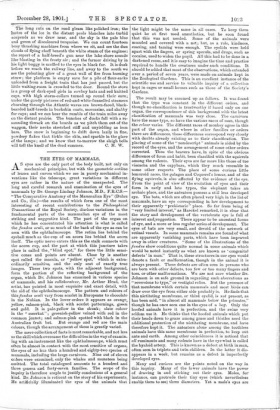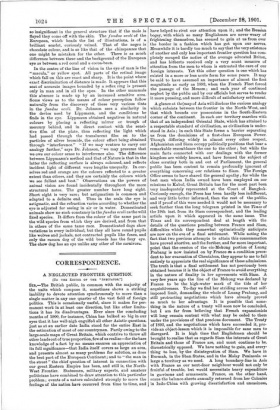THE EYES OF MAMMALS, £1. mechanical eyes are the only
part of the body built, not only on . mechanical principles, but with the geometric outline of lenses and curves which we see in purely mechanical in- ventions like the telescope, great variations in different eyes are rather in the nature of the unexpected. The long and careful research and examination of the eyes of mammals by Dr. George Lindsay Johnson, M.D., F.R.C.S.— " The Comparative Anatomy of the Mammalian Eye" (Dulau and Co., 21s.)—the .results of which form one of the most interesting of recent contributions to the Philosophical Transactions of the Royal Society, disclose variations in the fundamental parts of the mammalian eye of the most striking and suggestive kind. The part of the organ on which he has concentrated his attention is what is called the fundus mug or so much of the back of the eye as can be seen with the ophthalmoscope. The retina lies behind the eyeball much as the cup of an acorn lies behind the acorn itself. The optic nerve enters this as the stalk connects with the acorn cup, and the part at which this juncture takes place is called the,,,"blind spot," for there the little sensi- tive cones and points are absent. Close by is another spot called the macula, or "yellow spot," which is extra- ordinarily sensitive, and the only seat of exactly true images. These two spots, with the adjacent background, form the portion of the reflecting background of the organ, which Dr. Johnson has examined in various species of mammals, and his collaborateur, Mr. Arthur Head, the artist, has painted in most exquisite and exact detail, with the aid of the ophthalmoscope. The pattern and colours of this fundas oculi vary from scarlet in Europeans to chocolate in the Nubian. In the lower orders it appears as orange, yellow, salmon-pink, black with scarlet patternings, green and gold. It is pale-yellow in the skunk; slate colour in the " meerkat " ; greenish-yellow veined with red in the common jennet; and salmon-pink spotted with black in the Australian fruit bat. But orange and red are the main colours, though the arrangement of these is greatly varied. The mere collection of facts is most remarkable, and not less so the skill which overcame the difficulties in the way of examin- ing with an instrument like the ophthalmoscope, which must often be almost in contact with the most sensitive of organs, the eyes of no less than a hundred and eighty-two species of mammals, including the large carnivore. Nine out of eleven orders were examined, only the whales and manatees being omitted. The total catalogued amounts to a hundred and three genera and forty-seven families. The scope of the inquiry is therefore ample to justify conclusions of a general kind. Dr. Johnson is reticent on the story of his experiments. He artificially illuminated the eyes of the animals that
the light might be the same in all cases. To keep them quiet he at first used anastheties, but he soon found that this was not needed. Some of the animals were muzzled and covered with a net; but, as a rule, kindness, coaxing, and taming were enough. The eyelids were held apart with the fingers, or spring specula,, and drugs, such as cocaine, used to widen the pupiL All this had to be done in a darkened room, and it is easy to imagine the time and practice required to handle the creatures under such conditions. It should be added that most of the observations, which extended over a period of seven years, were made on animals kept in the Zoological Gardens. This is an excellent instance of the scientific use and service to valuable inquiry of a collection kept in cages or small houses such as those of the Society's Gardens.
The result may be summed up as follows. It was found that the type was constant in the different orders, and though no classification is trustworthy if based only on one organ, the correspondence of this background with the latest classification of mammals was very close. The carnivore have the same type, so have the various races of man, though the colour varies. The different races of monkey agree in this part of the organ, and where in other families or orders there are differences, these differences correspond very closely with doubts already existing as to their classification. The placing of some of the " nondescript " animals is aided by the record of the eyes, and the arrangement of some other orders corrected. Thus the beavers have, in spite of the obvious difference of form and habit, been classified with the squirrels among the rodents. Their eyes are far more like those of the viscacha and the capybara, which they much resemble in some other respects. The place of some curious little lemuroid races, the galagos and Coquerel's lemur, and of the flying squirrels, is also affected by the evidence of the eye. From the point of view of the evolution of eyes and their form in early and late types, the elephant takes an archaic place, and the anteaters possess a still less developed eye. The bats, which are often placed very high in the list of mammals, have an eye corresponding in low development to their apparently "prehistoric" place. So far from being of "very limited interest," as Haeckel remarked, it is clear that the story and development of the vertebrate eye is full of interest and:suggestion. There appear to be ancestral forms of eye, and a more or less regular series of development. The eyes of bats are very small, and devoid of the network of- retinal vessels. In some mammals remains are found of what are apparently vanishing parts, which have been improved away in other creatures. "Some of the illustrations of the fundus show conditions quite normal in some animals which would be noted instantly as what are known as 'congenital defects' in man." That is, these structures in our eyes would denote a fault or malformation, though in the animal it is always present. These defects are often seen in persons who are born with other defects, too few or too many fingers and toes, or other malformations. We are not sure whether Dr. Johnson is on safe ground in regarding such aberrations as "reversions to type," or vestigial relics. But the presence of that membrane which certain mammals and most birds can draw over the eye from either side probably is. He finds that this nictitating membrane, or third eyelid, is not present, as has been said, "in almost all mammals below the primates," though he has once seen one in the eyes of a boy. Only the hoofed animals have it in perfection, and the swine very seldom use it. He thinks that the hoofed animals which put their heads down to graze among grass and thistles need the additional protection of the nictitating membrane, and have therefore kept it. The anteaters alone among the _toothless animals have this same membrane in perfection, to keep out ants and earth. Among other coincidences it is noticed that all ruminants and many rodents have in the eye what is called the hyaloid artery. This is known as a defect at birth in man, often seen in triplets and twin children. In the latter it dis- appears in a week, but remains as a defect in imperfectly developed eyes.
Many and curious are the points noted on the way in this inquiry. Many of the lower animals have the power of drawing in and sticking out their eyes. Moles, foe instance, can protrude their tiny eyes (which nevertheless enable them to see) three diameters. Yet a mole's eyes are so insignificant in the general structure that if the mole is flayed they come off with the skin. The fundus oculi of the European, which heads the list of illustrations, is of a brilliant scarlet, curiously veined. That of the negro is chocolate colour, and is so like that of the chimpanzee that one might be mistaken for the other. There is as much difference between these and the background of the European eye as between a red coral and a cocoa-bean.
In the centre of the line of vision in the eye of man is the "macula," or yellow spot. All parts of the retinal image which fall on this are exact and sharp. It is the point where exact discrimination of distance is made. It appears that this seat of accurate images bounded by a reflex ring is present only in man and in all the apes. In the other mammals this absence is made up by an increased sensitive area. Some views as to the means of colour perception follow naturally from the discovery of these very various tints in the fundus oculi. Dr. Johnson sees a similarity in the device used by Lippmann, and the conditions he finds in the eye. Lippmann obtained negatives in natural colours by placing a reflecting mirror or trough of mercury behind, and in direct contact with the sensi- tive film of the plate, thus reflecting the light which had passed through the translucent film on to the particles of silver bromide, the colour effect being obtained through "interference." "If we may venture to carry our analogy further," says Dr. Johnson, "we may presume that we owe our colour sense to interference also. The difference between Lippmann's method and that of Nature is that in the latter the reflecting surface is always coloured, and reflects incident light of different wave lengths unequally. In our- selves red and orange are the colours reflected to a greater extent than others, and they are certainly the colours which we see fullest and best." Observations on the powers of animal vision are found incidentally throughout the more structural notes. The greater number have long sight. Short sight is very rare ; but astigmatism is common and adapted to a definite end. Thus in the seals the eye is astigmatic, and the refraction varies according to whether the eye is adjusted for seeing in air or in water. Domesticated animals show no such constancy in the fundus °cull as the wild fixed species. It differs from the colour of the same part in the wild species from IN-Lich they are derived, and from that in others of the same tame race. Domesticated dogs show variations in every individual, but they all have round pupils like wolves and jackals, not contracted pupils like foxes, and only the racoon dog of the wild breeds has the foxy eye. The chow dog has an eye unlike any other of the carnivora.



































 Previous page
Previous page